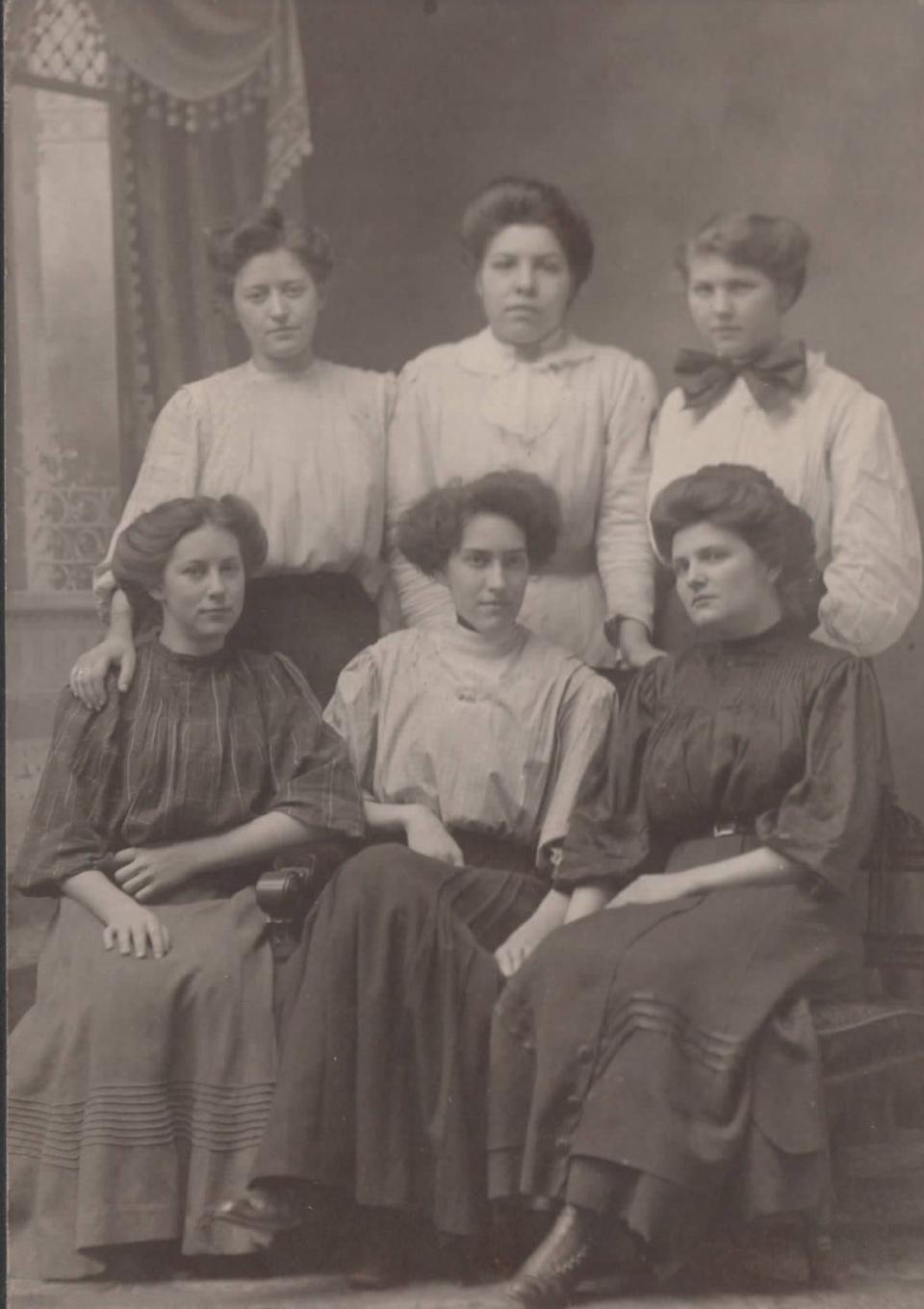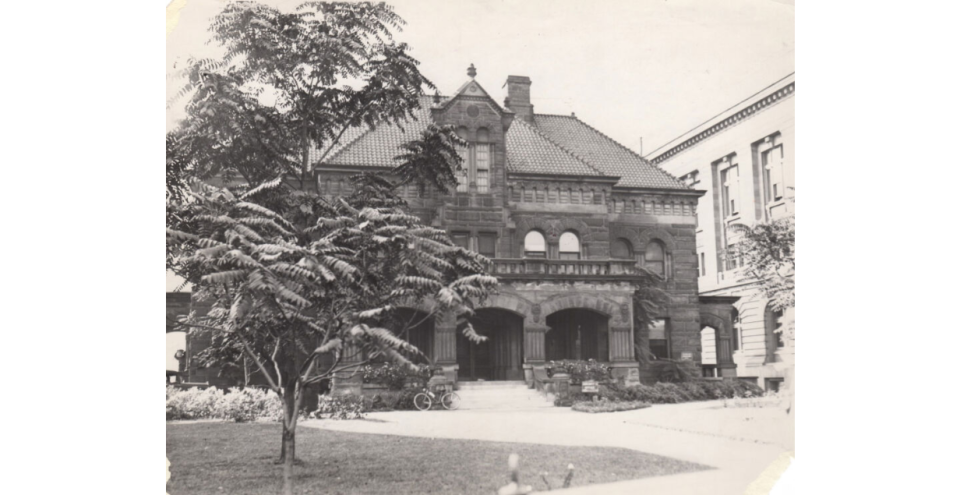Local history: Old photos found in box are relics of shocking tragedy

A murder victim was the last thing that Janette Stender expected to find while rummaging through a closet in her Tallmadge home.
She was sorting a big box of old photographs from her husband, Bob’s, family when she noticed writing on the backs of two pictures.
The first photo shows a studio portrait of six young women, apparently factory workers, clad in early 20th century attire. A note on the back reads: “The girls at Wadsworth Match with me.”
More: Former Kenmore school razed after fire: What happened to beloved mural?
The second portrait features a teen girl wearing a striped, high-buttoned dress, her long hair pulled back in a bow. She appears to be the same girl seated in the bottom right of the group photo.
The note on the back: “Minnie Brandt that got killed by Leo Deibel.”
The family historian, Stender didn’t recognize the faces in the photos and couldn’t identify the “me” written on the back. The scrawled names aren’t in the family genealogy. She doesn’t know why the pictures were kept.
Stender had stumbled across a shocking, tragic tale from more than 100 years ago.

The girl was Minnie Berndt (not Brandt), who vanished in January 1906 after going on a buggy ride with her boyfriend, Leo Deibel. She was in love and thought she was eloping.
Minnie, 17, was one of eight children born to Rosa and Charles “Karl” Berndt. The German American family lived in Chippewa Township near the hamlet of Hametown. Her father was a coal miner.
Leo, 19, the son of Louis and Barbara Deibel, lived on a farm in Franklin Township, now New Franklin, about 2 miles south of Johnson’s Corners in Norton Township. Leo’s father had killed himself in 1904, drinking carbolic acid after quarreling with his wife.
The teens met while working at the Barberton Pottery Co. and began a courtship. Minnie later took a job at the Wadsworth match factory.
The sweethearts dreamed of a future together, but Leo’s mother, 48, refused to let her son marry Minnie. Time was ticking. As the newspapers later reported, the girl was “in a delicate condition.”
Vanished in the night
On the evening of Jan. 28, 1906, Leo picked up Minnie in a buggy. She left home in a white shirtwaist, blue skirt, lace shoes, raincoat and turban. He drove her to his home.
“When we got there I unhitched my horse, put the buggy in the shed, and took Minnie to the haymow,” Leo later recalled. “I took several horse blankets and my dead father’s ulster, which was hanging in the barn, and then arranged a bed on the hay in one corner of the mow. I fixed a red handkerchief with some binding twine for a pillow.”
He didn’t tell his mother the girl was in the barn. His plan apparently was to persuade her to allow him to marry.
The next morning, he brought Minnie breakfast.
“I kept her there, and every time I got a chance, I went up and visited with her,” he said.
Three days passed. Barbara Deibel’s position was firm. She would not let her son marry that girl.
Forced to decide between eloping with his girlfriend or disobeying his mother, Leo chose the unthinkable.
He waited until late in the evening on Jan. 31 before going to the barn. He picked up the Winchester rifle that he used to shoot sparrows.
“I went to the haymow, and Minnie was sound asleep in the bed that I had arranged for her,” Leo said. “The rays from the moon shone through the cracks in the roof and her face was turned toward the roof of the barn.
“I climbed up into the rafters about 2 feet above her and about 10 feet away. I took deliberate aim at her head and fired.”
Minnie’s family began to worry about her whereabouts. Nearly four weeks after she left, her brother Louis Berndt went to Leo’s home to ask if he had seen Minnie.
Not recently, Leo said. He said he had dropped her off in Barberton at Second Street and Tuscarawas Avenue, and she took a streetcar to Akron for a job on Bowery Street.
“Leo said he gave her a dollar and she got on the car without bidding him goodbye and that was the last he had seen of her,” Louis recalled.
A gruesome discovery
Months passed. Seasons changed.
Farmhand Henry McMahon was searching the Deibel barn for eggs May 19 when an overpowering odor prompted him to look around. He reeled in horror after finding a girl’s decomposing body in the hay.
McMahon went to neighboring farmer Cameron Tope to report the gruesome discovery, and they drove to Barberton to notify Marshal David Fergusson.
Leo broke down after officers arrived at the Deibel farm.
“Mama, I have got to die,” he said. “They have found a corpse in the barn.”
Minnie’s family identified the remains through her clothing.
“Yes, it is our girl,” mother Rosa Berndt cried. “Our poor Minnie.”

As Marshal Fergusson grilled Leo, the boy sobbed: “I wanted to marry her and she wanted to marry me, but Mother objected.”
Deibel was arrested and transported to the Summit County Jail in Akron, where he confessed before Sheriff Jared Barker.
“I had intended burying the body some night, but every time I made up my mind, my nerve failed me, for I dearly loved the girl, and I could not touch her dead body,” Leo said.
The youth cried inconsolably when his mother visited him in jail.
“Leo, be brave,” Barbara Deibel ordered. “If you must die for this crime which you have committed, die like a man.”
As she left the cell, she began to cry, too.
“Oh, if I would only have allowed him to marry the girl,” she said. “It is too late now.”

Summit County Coroner Leroy B. Humphrey ruled that Minnie had died from a bullet to the right temple. He determined the girl had been about six months pregnant. The remains were buried at St. Augustine Cemetery on West Waterloo Road.
Leo pleaded guilty Oct. 13 to second-degree murder.
A scolding in courtroom
Summit County Common Pleas Judge Reuben M. Wanamaker expressed relief that there would be no trial, saying that such salacious proceedings “could not have worked anything but shame and disgrace upon the community and the morality of the public.”
At the sentencing, Wanamaker scolded Leo for killing Minnie. The judge sounded like a disappointed father.
“So far as the court is informed, your relations began with the highest motives and purposes,” Wanamaker said. “But with her love and devotion, she gave to you her innocence and honor.”
The judge said Leo should have made Minnie his lawful wife when he realized her “awful condition.”
“Whether through overwhelming love for your mother or in your own weakness, you did, however, refuse to do the least that you could have done by marrying her,” Wanamaker said. “Finally, you took her to the barn, that fatal barn, where she lost her life.”
He sentenced Leo to life at the Ohio Penitentiary in Columbus.
“I’m glad it’s over,” Leo cried afterward. “I would have married the girl had I had my own way because I did love her.”
He was supposed to spend the rest of his life behind bars, but it didn’t work out that way.
Paroled for good behavior
In 1915, the Ohio board of pardons commuted Leo’s sentence to 20 years. The state paroled him Dec. 15, 1916, for good behavior.
The murderer was free after 10 years.
Leo eventually got married and had children. He worked as a machinist in Alliance.
Forty years after killing Minnie, Leo killed himself.
Authorities said he got into a quarrel with his wife Feb. 19, 1946. After threatening to hurt her, he shot himself in the head. The 59-year-old was buried at Alliance City Cemetery.
Janette Stender doesn’t know why her husband’s family handed down Minnie’s photos. Bob’s grandfather Martin Stender and great-uncles Walter Stender and Arthur Fitts worked in the match industry. Fitts also was a professional photographer: Did he take the portraits?
Some relatives lived in Hametown near the victim. The family belonged to St. Augustine Church in Barberton, so there’s a possible connection there, too.
Stender may never know.
It’s a terrible, tragic story. She can’t begin to understand what was going through Leo’s mind when he killed his sweetheart on that night in 1906.
Now she knows the story behind the photos.
“Fascinating,” Stender said. “Not cheerful, but fascinating. And Minnie will now be remembered.”
Mark J. Price can be reached at mprice@thebeaconjournal.com.
More: Local history: Great Blizzard board game an icy blast from the past
More: Local history: The night the Akron Art Institute burned
This article originally appeared on Akron Beacon Journal: Local history: Old photos found in box are relics of shocking tragedy

